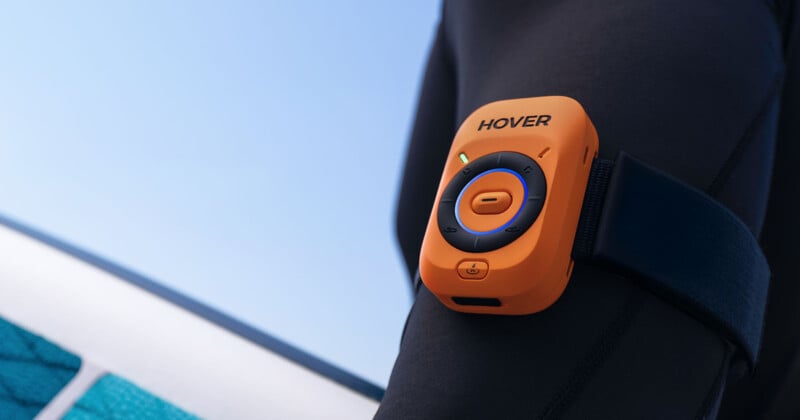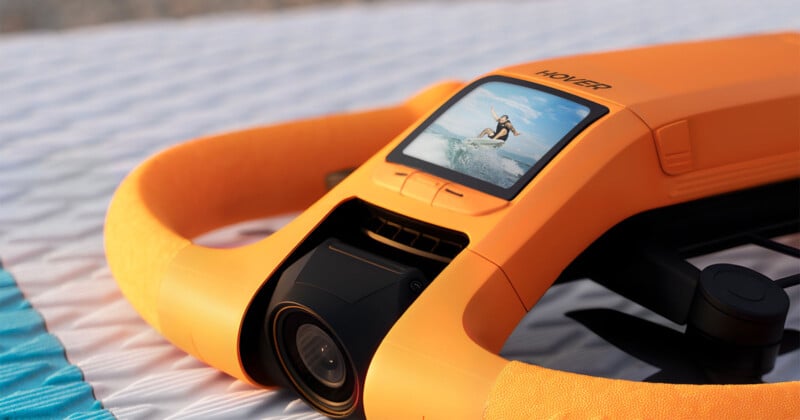HoverAir Aqua Is World’s First 100% Waterproof Self-Flying Camera
![]()
The HoverAir Aqua is the world’s first 100% waterproof self-flying camera. It floats, follows, and films water-based adventures, including paddleboarding, jet skiing, kayaking, and more.
First teased earlier this month, Aqua is the latest self-flying drone from HoverAir, the company behind the 8K X1 Pro and X1 Pro Max drones launched last year. The Aqua shares some key features with these drones, but HoverAir rebuilt nearly every component to ensure the Aqua is ready for waterborne adventures.
![]()
While the HoverAir Aqua has the same Type 1/1.28 CMOS image sensor as the X1 Pro Max, the surrounding components are mostly different, including the new hydrophobic lens and the drone’s body itself. By virtue of the waterproof case, which is not ideal for heat dissipation, the HoverAir Aqua lacks the 8K or 4Kp120 recording capabilities of the X1 Pro Max. Instead, the Aqua is capped at 4Kp100. That is sufficiently fast for 4x slow-motion at 24/25p playback, but not quite as capable of the 120 frames per second recording of the X1 Pro Max.
![]()
HoverAir Aqua can capture H-Log (10-bit) video, 12-megapixel photos (with HDR), and includes a 2x digital zoom. As for the hydrophobic lens, it also includes self-heating technology to prevent fogging in water.
This, along with the lack of any sort of neutral density (ND) filter solution, are the two primary compromises that the Aqua makes to achieve its waterproof design. Otherwise, the HoverAir Aqua is up to par with HoverAir’s other offerings while also promising unique capabilities.
![]()
![]()
The HoverAir Aqua features IP67 water resistance, neutral buoyancy, and AI-based tracking, allowing it to follow subjects as they enjoy their water adventures. The HoverAir Aqua features over 15 automated flight modes, including snorkel and mount modes, and has Level 7 wind resistance. For the snorkel mode, the drone’s camera can rotate to face directly down while it floats on the water’s surface, so it can follow divers as they swim.
Despite its waterproof design, the Aqua still weighs under 249 grams, so no FAA registration is required, and users in many countries and regions are free to use the drone without a special license. The Aqua’s battery provides up to 23 minutes of flight time, and the drone can reach tracking speeds up to 55 kilometers per hour (34 miles per hour). One quick note about the battery: the Aqua comes with a waterproof bag for extra batteries, and the battery must be changed in an entirely dry environment. A color-changing alert appears when the battery is wet, indicating it should not be placed inside the drone.
![]()
The HoverAir Aqua comes with a companion device, the Lighthouse. This is not an optional accessory, but an integral part of how Aqua works. This device, worn by the primary user, provides complete control over the Aqua, its shooting modes, takeoff, landing, recording, mode selection, and recall.

The device also has a Virtual Tether, which detects when Aqua is outside a set distance and will prompt the drone to return within range automatically. This ensures the Aqua doesn’t float away or get stuck while people are kayaking, paddle boarding, windsurfing, or doing something else swift on the water.
The Aqua has a 1.6-inch AMOLED display as well, so the user can get a live preview from the drone and quickly review footage without connecting a mobile device. This is excellent news for users who don’t want to take their smartphone with them out on the water and risk losing it.

“Aqua represents a natural extension of HoverAir’s mission to empower users to capture their greatest life moments hands-free and without boundaries — whether on land or water,” says MQ Wang, the founder and CEO of Zero Zero Robotics. The company was founded in 2014 by Stanford Ph.D.’s Wang and Tony Zhang.
Pricing and Availability
The HoverAir Aqua is launching first on Indiegogo and starts at $999 for early birds. HoverAir has launched its prior self-flying drones first on Indiegogo as well, so this is not an unusual launch strategy for the company. HoverAir says the Aqua will begin shipping in December.
Disclaimer: Make sure you do your own research into any crowdfunding project you’re considering backing. While we aim to only share legitimate and trustworthy campaigns, there’s always a real chance that you can lose your money when backing any crowdfunded project. PetaPixel does not participate in any crowdfunding affiliate programs.
To hold projects accountable, all crowdfunding campaigns on which PetaPixel reports are financially backed with the lowest tier option in order to give the publication visibility into all backer-only communications. If a campaign owner acts in a manner inconsistent with its promises, PetaPixel will share that information publicly.
Image credits: HoverAir